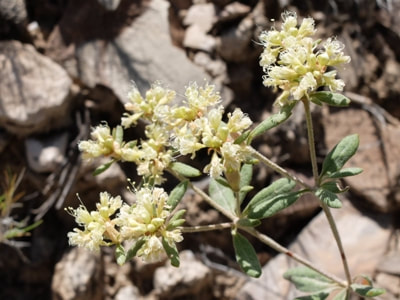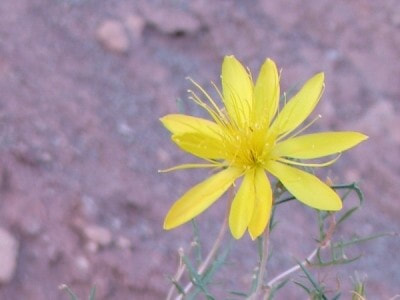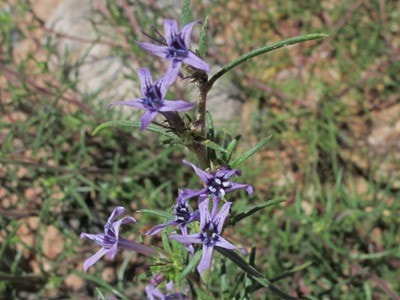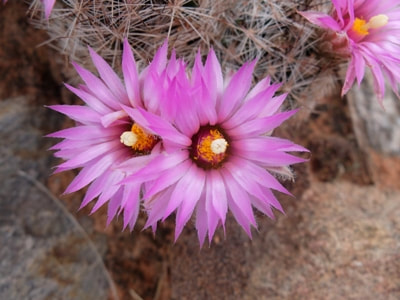|
Found in dry open rocky areas
Seen blooming in August in the Rio Chama Recreation Area At least nine members of the Buckwheat family grow in our area. James’ Buckwheat grows to 12" high with woody, branched stems. Leaves are spatula shaped and grow to 4" long in a basal rosette with long stalks. They are green on their upper side and densely hairy and silvery white below. The tiny flowers grow in round clusters and are creamy white and hairy underneath. Some Native American Indian tribes used this plant as a contraceptive and to ease the pain of childbirth. The root has been chewed as a cardiac medicine, as a treatment for stomach aches and to treat despondency. An infusion has also been used as a wash for sore eyes and the plant chewed to sweeten the saliva. Source. If you are trying to identify a different flower then you can check what other flowers bloom this month. If you cannot identify a flower from the website send a photo and where you took it to contact@rockymountainsflora.com. Read online for tips.
0 Comments
Chama Blazing Star, Remarkable Blazing Star, Mentzelia conspicua, Stickleaf Family (Loasaceae)8/16/2019 Found by roadsides, on barren slopes, in pinyon-juniper woodland
Seen blooming in August on FS Rd 151 in the Chama River Valley The recent monsoon rains have made many spring flowers bloom again, like the Spiny Blue Bowls, Red Bluets and Spectacle Pods. This is also the time for the Blazing Stars which do not open until late in the afternoon, during the day their flowers are tightly closed so are easily overlooked. Several species grow in the area but the Chama Blazing Star grows only in the Upper Chama River Basin and is listed as a New Mexico Rare Plant. It grows to 2 feet tall with branched white stems and rough leaves. The leaves are narrow with deeply cut teeth and are green on the upper surface with barbed hairs that stick to clothing and fur like Velcro. Flowers are bright golden yellow and solitary at the end of the branches. They are more than 2 inches across with 10 petals and long stamens. If you are trying to identify a different flower then you can check what other flowers bloom this month. If you cannot identify a flower from the website send a photo and where you took it to contact@rockymountainsflora.com. Read online for tips. Found in dry open areas
Seen blooming in August in Plaza Blanca Grows to 20”, shrub-like, with many branches. Leaves are narrow and dissected. Flowers are showy and purple, about ½" long with blue stamens and darker purple speckles around the throat. It is used as a drug by several Native American peoples; the Navajo used a decoction of plant as a ceremonial medicine, the Zuni made a powder and applied it to the face for headaches, and as a dermatological aid applied to wounds. Source. If you are trying to identify a different flower then you can check what other flowers bloom this month. If you cannot identify a flower from the website send a photo and where you took it to contact@rockymountainsflora.com. Read online for tips. Found in sandy, rocky soils in grasslands and woodlands
Seen blooming in June and August in Red Wash Canyon It was hard to miss the many, bright, magenta blooms of the tree-like Cholla cactus which had a super-bloom this year but it was easy to miss the equally bright, Spinystar which grows in a tight ball on the ground, like a spiny tennis ball. Spines are light to brown colored with dark tips. Flowers are more than an inch across and have fringed, hot pink to magenta petals with bright orange stamens and a white stigma. They produce a small green berry that can be eaten raw and boiled, and are useful in small amounts against diarrhea. Source. If you are trying to identify a different flower then you can check what other flowers bloom this month. If you cannot identify a flower from the website send a photo and where you took it to contact@rockymountainsflora.com. Read online for tips. Found in dry open areas and slopes
Seen blooming in July in Poshuouinge, Santa Fe NF Rubberweeds grow less than a foot tall with leafy stems and many, bright yellow flowers. The leaves are divided into narrow segments. Flower heads usually have 8 petals, but can have more, and are about ¾ inch across. The petals have three-toothed tips and droop when the plant ages. The flowers provide a yellow dye for wool. Hopi and Navajo used the bark of the roots as a chewing gum, due to the roots having a milky sap that contains latex. The stems/leaves were also used to make a tea and a poultice used to treat wounds. It was also used by the Navajo as an emetic in the Evil Way ceremony. It is toxic to livestock. Source. If you are trying to identify a different flower then you can check what other flowers bloom this month. If you cannot identify a flower from the website send a photo and where you took it to contact@rockymountainsflora.com. Read online for tips. |
AuthorI am Marilyn Phillips, a native of England, whose love of nature and the outdoors from childhood brought me by a circuitous route to Crested Butte, Colorado in 1993 and 16 years later to northern New Mexico. My exploration of the many trails in these areas, my interest in wildflowers and photography, and career in computer system design came together in this creation. If you have any corrections, comments or questions, please contact me by email. Archives
September 2024
Categoriescopyright © 2020
|







 RSS Feed
RSS Feed